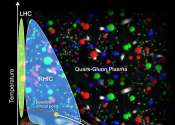Analysis of lightweight nuclei from gold ion collisions offers insight into primordial matter phase changes
Physicists analyzing data from gold ion smashups at the Relativistic Heavy Ion Collider (RHIC), a U.S. Department of Energy (DOE) Office of Science user facility for nuclear physics research at DOE's Brookhaven National Laboratory, ...









